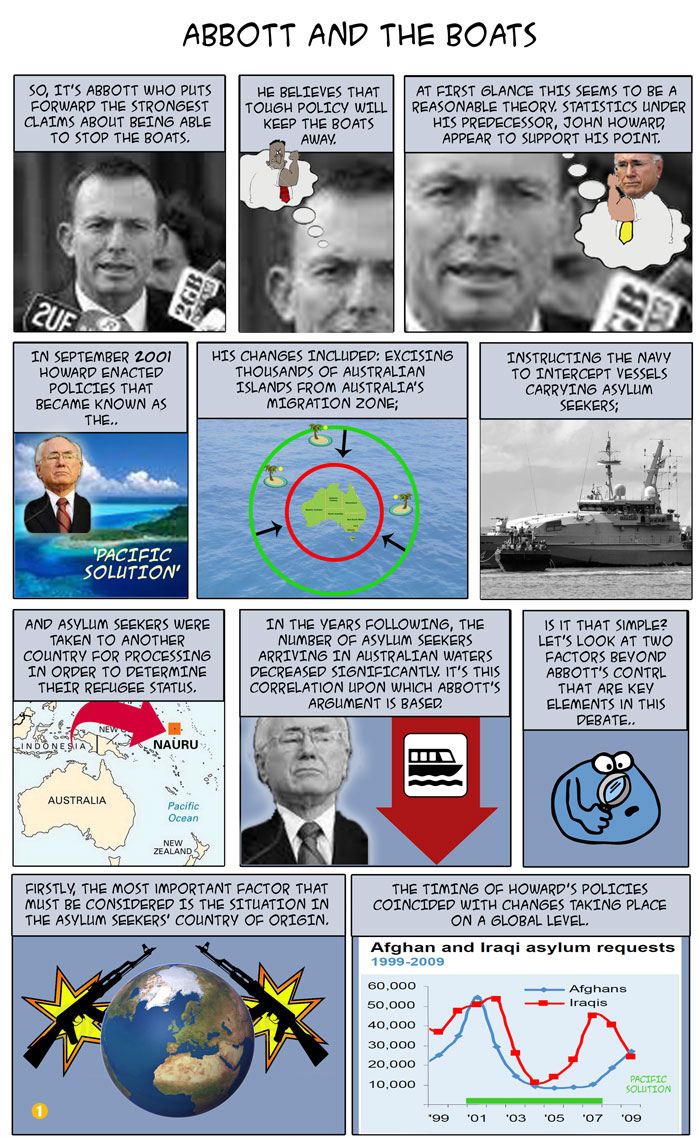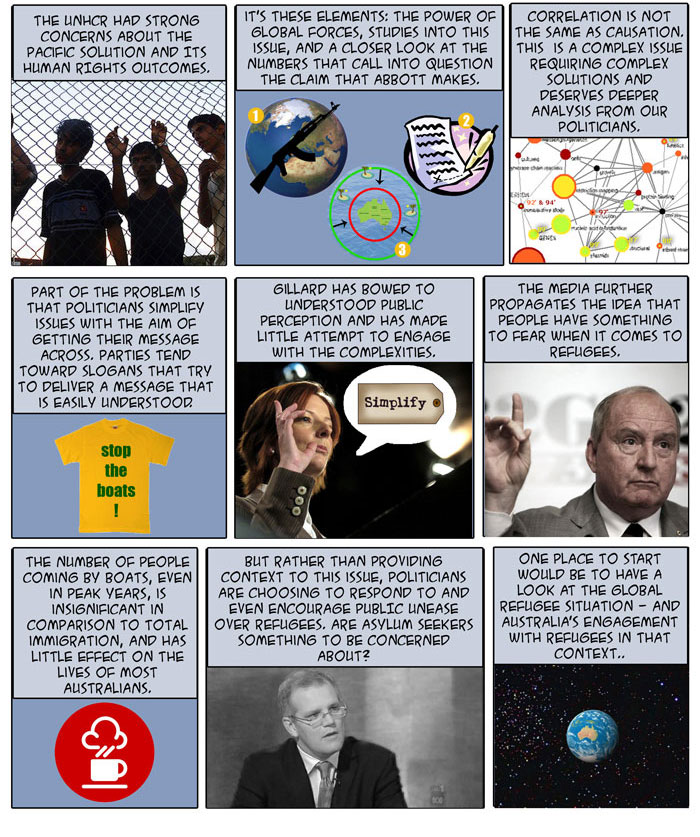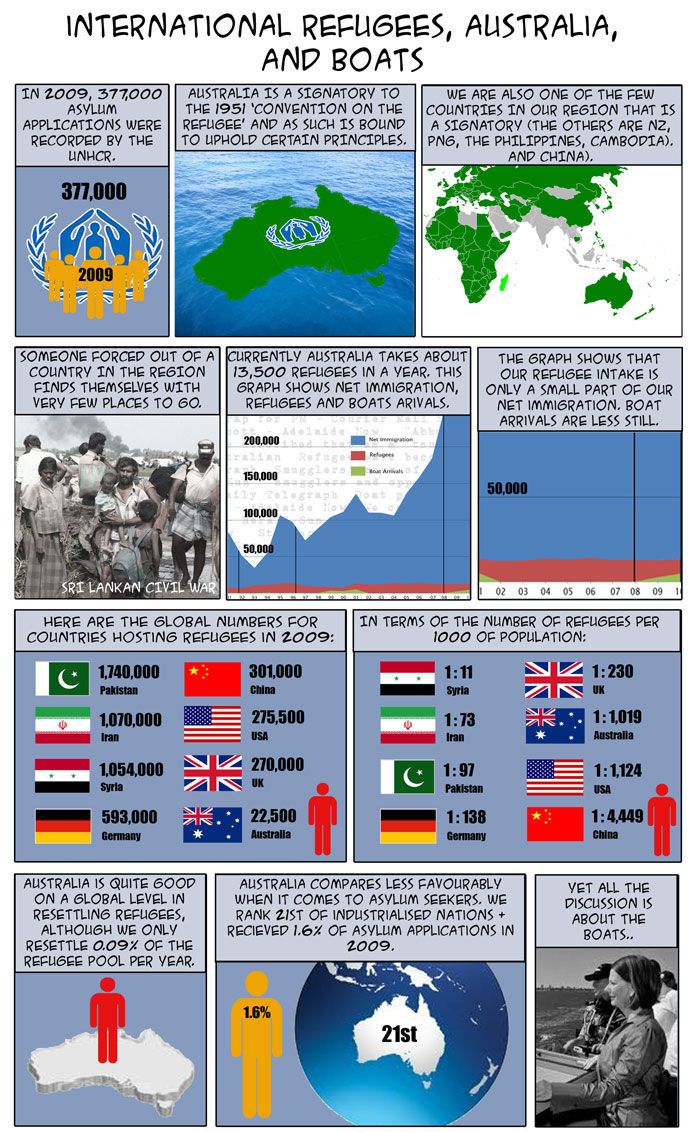It's been a pretty good few weeks of responses to our project, and a pretty miserable although interesting end to the election - one that seemed somehow fitting. We were very happy with what we produced and the coverage it received and would like to thank all those who helped out in producing and distributing. Not a cent was gained in the process, but hopefully the message reached a few minds. The number of unique visitors has now ticked over 7,000 after almost four weeks, and the map of Australian views is interesting, with, for instance, well over 400 in Brisbane and a similar number in a couple of other capitals – and notably, one in Kalgoorlie. We covered the map. These aren’t record breaking figures, but not bad for a first attempt - and it won’t be the last. I also thought I should take the chance to respond to the comments and criticisms.
The most important thing that I’d be keen to point out is that we aimed to provide information. In a nutshell, that was it. The issue of asylum seekers, refugees and boat arrivals is easily described in terms of numbers. The complexity resides in the politics, and the associated elements – the media, the populism, the dynamics of the changes over time, the global forces, the related economics and financial aspects. We were keen here to concentrate on the things that appeared to not be a part of the public debate often enough but that should be, and present them in a format that might help the ideas to stick in people’s minds, possibly reaching a few extra people who might not read a long article. And while I would happily acknowledge that it wouldn’t be hard for the discerning reader to gauge the political leanings of the makers, we were striving to present the facts that we thought were pertinent without too much by the way of comment – and comment is only as powerful as the person making it. Facts were where we could hit our mark.
But what I have written so far ignores the central impetus of our mission. A major motivational factor had been the startling rhetoric coming out of the political leaders which appeared to be descending into farce. I’ve had many a chat (and argument) with people about the interaction of the public, the media and the politicians. On the topics we tackled there seemed to be the worst confluence of factors drawing the debate towards the darker potential that it has to offer. I don’t expect everyone to be comfortable with people of different appearance and culture arriving on our shores. I don’t expect all those who discuss the issue in the media to agree with my point of view, and as much as I may vent against some of the things I read, I see these differences (well, some of them) as vital to our democracy. Having lived my politically formatives years for many years under a Howard government I also am very familiar with disagreement with those in power. But of the three groups here, I hold the media to a higher standard than those who ring in to talk-back radio, and politicians to a higher standard again.
In this election campaign many in the media were outstanding in presenting the issues – there were dozens of brilliant articles written (and in the years before this) that served to inform and find context for this complex issue. But it’s the strident and often wrong that were listened to by the politicians and that coloured the approach that they took towards the issue in the campaign – and it was this that we were reacting to. While I don’t imagine that Australia can be the saviour of the world’s problems I do think that we are probably a little ahead of what has been on show in recent months, and I’d like to think that we might do a bit better in the future. It seems that there is an unwillingness to engage with complexity and to educate and lead by those in power, rather, they turn to the public to gauge the feeling of the community and react to that in our culture that they presumably feel is better not to change – but to nurture. When this type of politics results in demonising asylum seekers and even seeks to promote fear and concern in the community then we have grave problems with the functioning of our society. You can see the outcomes of this in the cynical and clearly political changes in the changes in the percentage of asylum seekers recognised by the Australian government as refugees as the issue became higher in profile and as the opposition carelessly used these boat arrivals to attempt to gain political capital.
There were, of course, issues that we didn’t cover. Intuitivereason commented that identifying problems is easy, but I disagree. I doubt that a high percentage of people in Australia have a sense of the graph we produced and less would they have more than the vaguest idea of the global situation. What exactly the problem is and the scale of the issue is integral to finding a solution, and especially as this will be undertaken by government and explanation of the issue and the reasons for the chosen solution are vital. Taking David Bradbury, the MP from land locked Lindsay in Western Syndey on a boat into the Timor Sea is not one of them – this is at best a cynical political manoeuver. They also suggested that we follow it up with a workable proposal, which I would be happy to attempt given the time and resources, but, without backing away from the challenge entirely, this was beyond the remit of our project – by educating we hoped to grant more political capital to the elected officials who have the intelligence and the patience to attend to the task and find appropriate solutions. Amy brought up the question of the queue and the current legal situation involved with family reunions as well as the issue of temporary protection visas. In short, TPVs don’t work to stop the boats (see the graph). This would need to be shown to justify their implementation and the reasons for implementing them better explained. By all means sell me a point to put in the ‘for’ column. Regarding the queue, consider that less than 1% of the world’s refugees are resettled in a year. There are people who wait for up to seventeen years in UNHCR run camps. In a sense there must be some queue, but not as people imagine and so if we are going to discuss the queue, then we would be well advised to gain a deeper understanding of the global forces and the international capacity to both stop the situations creating these displaced people, and capacity of third countries accept those displaced. I would suggest that, for example, on many measurements Indonesia bears a much larger burden share than Australia.
And some of the most interesting discussions occurred over the issue of the role of people smugglers. Both AM and JW (with whom I had an excellent discussion) had some concerns about the language I used in this regard. As a recent four corners showed, people smuggling and the corruption that is a corollary to the movement of people out of danger (and out of economic hardship) is a major problem in Indonesia. And the featured people smugglers were also shown to be opportunists and crooks and people who are essentially taking advantage of the misfortune of others. Not all, but many. But to change the debate to be one of putting these people out of business rather than fostering a better understanding of the forces that lead people to require smugglers’ services seems disingenuous to me. And to attempt to demonise them with such colorful language bordered on the ridiculous. Again I return to my original point – a deeper understanding and assessment of the issues will reap far better solutions than the hyperbole and game-playing that the polity engaged in. Having watched neo-liberalism become virtually a religion for both sides of politics over the past 30 odd years it seems almost laughable to deride those in such a poor country for their entrepreneurial spirit in providing this dubious service. It’s not good for Australia, but the fact that the people these smugglers help are unfortunate doesn’t mean that they don’t want their services. This is different from the drug, gun or sex trade. And of course, again, this is not all of the sides. Something that I have read recently talks of 891 people drowning between 1999 and 2001 and a further 150 between January last year (2009) and June this year. What do people know of these figures? How many times have these been seen as relevant to the debate? The general population is not given the respect.
In this they were helped in no small part by some of the worst aspects of the media. I reserve a special mention here for Denham Hitchcock of A Current Affair and Michael Smith of 4BC in Brisbane whose contributions to the level of misinformation were heroic, and who strode forth into the world unburdened by facts or any regard for the harm that they could cause. There is no justifying the content of their reports, so they fall into the category of ignorant and lazy or malicious and mercenary. Neither choice is flattering – but they are the only ones on offer. These two represent simply the nastiest (or most careless) edge of this debate, but by no means the only perpetrators (special mention here must go to Howard Sattler, Andrew Bolt and the evergreen Alan Jones). I’m sure these people represent the sentiment in the community to some degree (and help cement these views as acceptable), but also that they have an influence on it too, where a distorted statistic could change an opinion. I’m not interested in moral relativity over this issue – they are wrong, and demonstrably so. The trouble is that sometimes it can just take a bit longer to explain that. And it’s because of people like this that the politicians end up saying the ridiculous things that they do. If they were stronger leaders it wouldn’t happen. This isn’t a case of just having a different view point or a different set of values. That is fine. These are people who misrepresent the reality to further their agenda, be in social or financial. It shouldn’t be tolerated.
I do want to say a quick word about the possible solutions and I urge our elected officials and their bureaucracy to think long and hard about them themselves. The pacific solution was an Australian disgrace. Even if this solution brought about the changes that were claimed (and my view is that it had a marginal effect) we lost so much more in the process. Clearly these were terribly harsh measures, and to be able to implement them politically, the government reached for the language of polemic and brought to the surface of our societies the worst aspects of our sometimes natural tendency toward xenophobia. It then wasn’t just the harm done to the people who came by boat in a physical and psychological sense, but further insidious effects and the damage done to the wider community, fuelling mistrust and exacerbating social tension. Immigrants of any stripe were made to feel unwelcome, and being largely politically powerless they just had to wear it. The actions of our leaders can shape the social landscape and they have a responsibility to at least attempt to do better. I suggest we don’t return to this 'solution'.
In the end this was our small effort to adjust some of the views by adding to the facts that people had at their disposal. And in the end we got to a few but probably changed few minds. At the very least I hope that it was enjoyable. Below are some of the best articles that we read in putting this together (although far from exhaustive and I will attempt to add to it as I rediscover some that I have left off). We shall be back in the near future with another project, this time on climate change.
Thanks for reading,
Batteries
(with C4 and No_Fuss)
Peter Mares – The fifth ripple
Ben Eltham – Gillard on migration: how the worm turns








